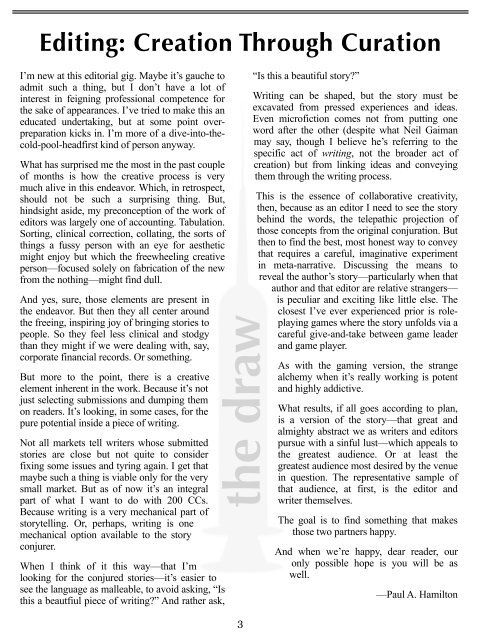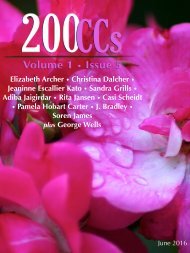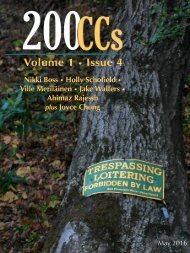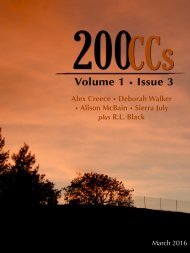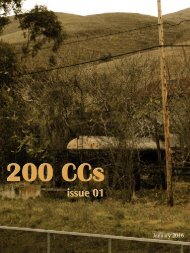200 CCs - February 2016
Volume 1, Issue #2
Volume 1, Issue #2
Create successful ePaper yourself
Turn your PDF publications into a flip-book with our unique Google optimized e-Paper software.
the draw<br />
Editing: Creation Through Curation<br />
I’m new at this editorial gig. Maybe it’s gauche to<br />
admit such a thing, but I don’t have a lot of<br />
interest in feigning professional competence for<br />
the sake of appearances. I’ve tried to make this an<br />
educated undertaking, but at some point overpreparation<br />
kicks in. I’m more of a dive-into-thecold-pool-headfirst<br />
kind of person anyway.<br />
What has surprised me the most in the past couple<br />
of months is how the creative process is very<br />
much alive in this endeavor. Which, in retrospect,<br />
should not be such a surprising thing. But,<br />
hindsight aside, my preconception of the work of<br />
editors was largely one of accounting. Tabulation.<br />
Sorting, clinical correction, collating, the sorts of<br />
things a fussy person with an eye for aesthetic<br />
might enjoy but which the freewheeling creative<br />
person—focused solely on fabrication of the new<br />
from the nothing—might find dull.<br />
And yes, sure, those elements are present in<br />
the endeavor. But then they all center around<br />
the freeing, inspiring joy of bringing stories to<br />
people. So they feel less clinical and stodgy<br />
than they might if we were dealing with, say,<br />
corporate financial records. Or something.<br />
But more to the point, there is a creative<br />
element inherent in the work. Because it’s not<br />
just selecting submissions and dumping them<br />
on readers. It’s looking, in some cases, for the<br />
pure potential inside a piece of writing.<br />
Not all markets tell writers whose submitted<br />
stories are close but not quite to consider<br />
fixing some issues and tyring again. I get that<br />
maybe such a thing is viable only for the very<br />
small market. But as of now it’s an integral<br />
part of what I want to do with <strong>200</strong> <strong>CCs</strong>.<br />
Because writing is a very mechanical part of<br />
storytelling. Or, perhaps, writing is one<br />
mechanical option available to the story<br />
conjurer.<br />
When I think of it this way—that I’m<br />
looking for the conjured stories—it’s easier to<br />
see the language as malleable, to avoid asking, “Is<br />
this a beautfiul piece of writing?” And rather ask,<br />
3<br />
“Is this a beautiful story?”<br />
Writing can be shaped, but the story must be<br />
excavated from pressed experiences and ideas.<br />
Even microfiction comes not from putting one<br />
word after the other (despite what Neil Gaiman<br />
may say, though I believe he’s referring to the<br />
specific act of writing, not the broader act of<br />
creation) but from linking ideas and conveying<br />
them through the writing process.<br />
This is the essence of collaborative creativity,<br />
then, because as an editor I need to see the story<br />
behind the words, the telepathic projection of<br />
those concepts from the original conjuration. But<br />
then to find the best, most honest way to convey<br />
that requires a careful, imaginative experiment<br />
in meta-narrative. Discussing the means to<br />
reveal the author’s story—particularly when that<br />
author and that editor are relative strangers—<br />
is peculiar and exciting like little else. The<br />
closest I’ve ever experienced prior is roleplaying<br />
games where the story unfolds via a<br />
careful give-and-take between game leader<br />
and game player.<br />
As with the gaming version, the strange<br />
alchemy when it’s really working is potent<br />
and highly addictive.<br />
What results, if all goes according to plan,<br />
is a version of the story—that great and<br />
almighty abstract we as writers and editors<br />
pursue with a sinful lust—which appeals to<br />
the greatest audience. Or at least the<br />
greatest audience most desired by the venue<br />
in question. The representative sample of<br />
that audience, at first, is the editor and<br />
writer themselves.<br />
The goal is to find something that makes<br />
those two partners happy.<br />
And when we’re happy, dear reader, our<br />
only possible hope is you will be as<br />
well.<br />
—Paul A. Hamilton


